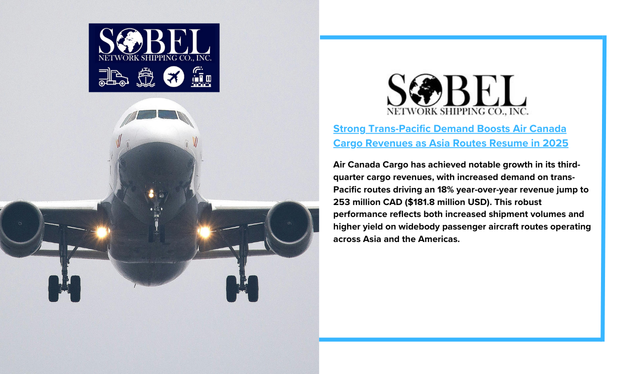Sustained Trans-Pacific Demand Drives Growth for Air Canada Cargo
Air Canada Cargo has achieved notable growth in its third-quarter cargo revenues, with increased demand on trans-Pacific routes driving an 18% year-over-year revenue jump to 253 million CAD ($181.8 million USD). This robust performance reflects both increased shipment volumes and higher yield on widebody passenger aircraft routes operating across Asia and the Americas.
Market Trends and Future Projections
Mark Galardo, Air Canada’s President of Cargo, emphasized the favorable conditions across the Asia-Pacific region, with strong demand trends in markets like India and China. “We’re optimistic about ongoing cargo tailwinds moving into the fourth quarter and early next year,” Galardo shared, noting the strength of the air cargo sector even in traditionally slower regions.
Air Canada expects this demand to persist, buoyed by trends observed by logistics leaders like DHL Global Forwarding, which forecasts steady trans-Pacific shipping volumes from Asia to North America in early 2025.
Fleet Strategy and Network Optimization
The third quarter’s revenue gains were also supported by Air Canada Cargo’s fleet of six Boeing 767-300 freighters operating throughout the Americas. While growth was offset by lower trans-Atlantic revenues, Air Canada’s flexible freighter-to-belly commercial model has proven resilient. This approach enables cargo load balancing across its passenger routes and cargo freighters, creating robust connectivity for North American and international shippers.
Earlier this year, Air Canada adjusted its fleet to align with market demand, removing two Boeing 767-300 freighters from service and canceling orders for additional 777 freighters. Despite these cuts, the resumption of daily flights from Vancouver to Shanghai and Beijing starting December 7th is expected to generate additional revenue. Operated by Boeing 787 Dreamliners, these flights mark a significant increase in Air Canada’s trans-Pacific capacity following recent traffic limit removals between Canada and China.
Industry-Wide Growth in Air Cargo
Airlines and logistics providers have reported consistent demand growth for air cargo services, especially in 2024, as total shipping volumes rose by 11% through September. Increased e-commerce demand, alongside perishable goods and time-sensitive shipments, have filled flights across trans-Pacific and Asia-to-Europe routes. This trend reflects shippers’ increasing reliance on air freight to avoid maritime delays.
Compared to other major airlines, Air Canada’s growth was notable, with Delta, United, and Lufthansa also reporting strong cargo revenue increases for the quarter. Delta Air Lines saw a 27% rise to $196 million, while United Airlines grew 25% to $415 million.
Cold-Chain Facility Expansion
Air Canada has continued to expand its logistical capabilities in response to market demand. Last month, Air Canada Cargo opened a new cold-chain facility at London Heathrow, the airline’s largest European hub, enhancing temperature-controlled storage options for temperature-sensitive goods. This facility upgrade represents Air Canada’s commitment to supporting specialized cargo segments in international markets.
Company-Wide Results Surpass Analyst Expectations
Air Canada’s broader financial results for Q3 outpaced analyst predictions despite a 4% decline in total revenue, which settled at $4.4 billion. Adjusted operating income also fell by $220 million to reach $1 billion, primarily due to oversupply in domestic passenger services. The company also averted a significant labor disruption by negotiating a new pilot contract in September, finalized on October 18, further stabilizing its operational outlook.
As Air Canada Cargo continues its upward trajectory and strategically adjusts to market dynamics, the company remains well-positioned to capitalize on growing demand in the Asia-Pacific region into 2025 and beyond.


